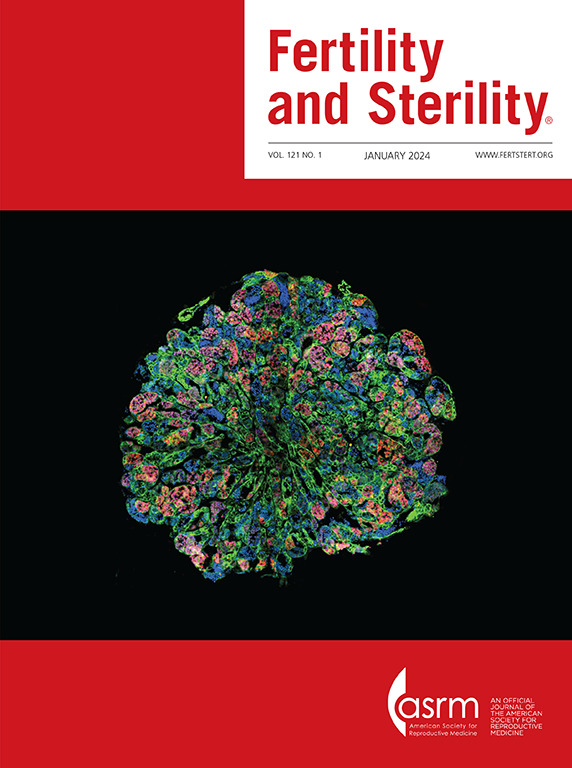Is Endometriosis a Progressive Disease? Examining Age-Related Trends in disease Severity and Surgical Complexity.
IF 7
1区 医学
Q1 OBSTETRICS & GYNECOLOGY
引用次数: 0
Abstract
OBJECTIVE To study the relationship between age and the phenotypic expression and surgical complexity of endometriosis using the AAGL classification. DESIGN Retrospective cohort study. SUBJECTS Patients aged 18-51 years with pathology-confirmed stage III-IV endometriosis. EXPOSURE We analyzed patients who underwent laparoscopic or robotic-assisted endometriosis surgery between 2013 and 2023 at a quaternary care institution in the United States. Patients were stratified into four age groups (≤25, 25-35, 35-45, >45). MAIN OUTCOME MEASURES The primary outcome was age related differences in disease severity (AAGL Classification), surgical complexity (AAGL Level A-D), the presence of endometrioma and bowel endometriosis. Secondary outcomes included association with clinical presentation, imaging findings, and surgical complications. RESULTS A total of 1,293 patients met inclusion criteria. AAGL stage III-IV prevalence increased with age, peaking at 50.5% in the 35-45 age group, then stabilizing at 47.0% in the >45 year group (p<.001). AAGL surgical complexity continued to rise steadily with Level C increasing from 21.1% (≤25 years) to 58.3% (>45 years). In multivariable regression, compared to patients aged <25 years, those aged 25-35, 35-45, and >45 had significantly higher odds of AAGL Stage III-IV disease (adjusted odds ratio [aOR] 2.47, 95% CI 1.35-4.49; 2.54, 95% CI 1.40-4.61; and 2.84, 95% CI 1.42-5.66, respectively). Surgical complexity (AAGL Level C-D) significantly increased beyond age 35, with aOR of 2.13 (95% CI 1.22-3.72) for ages 35-45 and 4.46 (95% CI 2.32-8.59) for patients >45. The odds of having endometriomas was higher for all age groups compared to age <25 (aOR 3.05, 95% CI 1.73-5.39 for ages 25-35, aOR 3.24, 95% CI 1.84-5.70 for ages 35-45, and aOR 2.58, 95% CI 1.34-4.96 for ages >45). No significant association between age and bowel endometriosis was found. CONCLUSIONS AAGL disease stage peaks around ages 25-35 and subsequently plateaus, while surgical complexity continues to increase beyond this age, reaching the highest odds in patients over 45, likely reflecting cumulative fibrosis, adhesions, and anatomical remodelling. These findings highlight the importance of individualized, age-specific treatment approaches to reduce surgical complexity later in life. Future research should further refine these age-based management strategies.子宫内膜异位症是一种进行性疾病吗?检查疾病严重程度和手术复杂性的年龄相关趋势。
目的应用AAGL分型法研究子宫内膜异位症患者的年龄与表型表达及手术复杂度的关系。设计回顾性队列研究。患者年龄18-51岁,病理证实为III-IV期子宫内膜异位症。我们分析了2013年至2023年间在美国一家第四医疗机构接受腹腔镜或机器人辅助子宫内膜异位症手术的患者。患者分为4个年龄组(≤25岁,25-35岁,35-45岁,bb0 -45岁)。主要结局指标主要结局指标是疾病严重程度(AAGL分级)、手术复杂性(AAGL A-D级)、子宫内膜异位症和肠内膜异位症的年龄相关差异。次要结局包括与临床表现、影像学表现和手术并发症的关联。结果1293例患者符合纳入标准。AAGL III-IV期患病率随年龄增长而增加,35-45岁年龄组最高达50.5%,45岁年龄组稳定在47.0%。在多变量回归中,与45岁的患者相比,AAGL III-IV期疾病的发生率明显更高(调整后的优势比[aOR]分别为2.47,95% CI 1.35-4.49; 2.54, 95% CI 1.40-4.61; 2.84, 95% CI 1.42-5.66)。35岁以后,手术复杂性(AAGL Level C-D)显著增加,35-45岁的aOR为2.13 (95% CI 1.22-3.72), 45岁以下的aOR为4.46 (95% CI 2.32-8.59)。与45岁的人相比,所有年龄组患子宫内膜异位瘤的几率都更高。年龄与肠道子宫内膜异位症之间没有明显的联系。结论:saagl疾病阶段在25-35岁左右达到顶峰,随后进入平稳期,而手术复杂性继续增加,在45岁以上的患者中达到最高,可能反映了累积纤维化、粘连和解剖重构。这些发现强调了个性化的、针对特定年龄的治疗方法对于减少生命后期手术复杂性的重要性。未来的研究应该进一步完善这些基于年龄的管理策略。
本文章由计算机程序翻译,如有差异,请以英文原文为准。
求助全文
约1分钟内获得全文
求助全文
来源期刊

Fertility and sterility
医学-妇产科学
CiteScore
11.30
自引率
6.00%
发文量
1446
审稿时长
31 days
期刊介绍:
Fertility and Sterility® is an international journal for obstetricians, gynecologists, reproductive endocrinologists, urologists, basic scientists and others who treat and investigate problems of infertility and human reproductive disorders. The journal publishes juried original scientific articles in clinical and laboratory research relevant to reproductive endocrinology, urology, andrology, physiology, immunology, genetics, contraception, and menopause. Fertility and Sterility® encourages and supports meaningful basic and clinical research, and facilitates and promotes excellence in professional education, in the field of reproductive medicine.
 求助内容:
求助内容: 应助结果提醒方式:
应助结果提醒方式:


